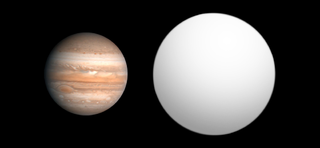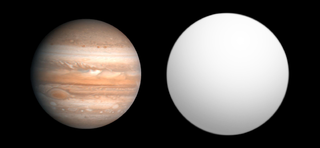Related Research Articles
OGLE-TR-111 is a yellow dwarf star approximately 5,000 light-years away in the constellation of Carina. Having an apparent magnitude of about 17, this distant and dim star has not yet been cataloged. Because its apparent brightness changes when one of its planets transits, the star has been given the variable star designation V759 Carinae.

OGLE-TR-10 is a distant, magnitude 16 star in the constellation of Sagittarius. It is located near the Galactic Center. This star is listed as an eclipsing type variable star with the eclipse due to the passage of the planet as noted in the discovery papers.
OGLE-TR-132 is a distant magnitude 15.72 star in the star fields of the constellation Carina. Because of its great distance, about 4,900 light-years, and location in the crowded field it was not notable in any way. Because its apparent brightness changes when one of its planets transits, the star has been given the variable star designation V742 Carinae. The spectral type of the star is type F. A yellow-white, very metal-rich dwarf star, it is slightly hotter and more luminous than the Sun.

OGLE-TR-10b is an extrasolar planet orbiting the star OGLE-TR-10.
OGLE-TR-56 is a dim, distant, magnitude 17 Sun-like star located approximately 1,500 parsecs away in the constellation of Sagittarius. This star is listed as an eclipsing type variable star with the eclipse due to the passage of the planet as noted in the discovery papers.

OGLE-TR-56b is an extrasolar planet located approximately 1500 parsecs away in the constellation of Sagittarius, orbiting the star OGLE-TR-56. This planet was the first known exoplanet to be discovered with the transit method. The object was discovered by the OGLE project, announced on July 5, 2002 and confirmed on January 4, 2003 by the Doppler technique. The period of this confirmed planet was the shortest until the confirmed discovery of WASP-12b on April 1, 2008. The short period and proximity of the OGLE-TR-56 b to its host mean it belongs to a class of objects known as hot Jupiters.
OGLE-2005-BLG-169L is a dim and distant magnitude 20 galactic bulge star located about 2,700 parsecs away in the constellation Sagittarius. If it is a main sequence star, then it is most likely a red dwarf with about half of the mass of the Sun. Other possibilities are a white dwarf star, or a neutron star or black hole.

CoRoT-1b is a transiting extrasolar planet approximately 2,630 light-years away in the constellation of Monoceros. The planet was discovered orbiting the yellow dwarf star CoRoT-1 in May 2007. The planet was the first discovery by the French-led CoRoT Mission.
OGLE-TR-113 is a dim, distant magnitude 16 binary star in the star fields of the constellation Carina. Because of its distance of about 1170 light years, and location in a crowded field it was not notable in any way. Its apparent brightness changes when one of its planets transits, so the star has been given the variable star designation V752 Carinae. Spectral type of the star is type K dwarf star, slightly cooler and less luminous than the Sun.
OGLE-TR-211 is a distant magnitude 14 star located about 5,700 light years away in the constellation of Carina.

WASP-11b/HAT-P-10b or WASP-11Ab/HAT-P-10Ab is an extrasolar planet discovered in 2008. The discovery was announced by press release by the SuperWASP project in April 2008 along with planets WASP-6b through to WASP-15b, however at this stage more data was needed to confirm the parameters of the planets and the coordinates were not given. On 26 September 2008, the HATNet Project's paper describing the planet which they designated HAT-P-10b appeared on the arXiv preprint server. The SuperWASP team's paper appeared as a preprint on the Extrasolar Planets Encyclopaedia on the same day, confirming that the two objects were in fact the same, and the teams agreed to use the combined designation.

OGLE-TR-182b is a transiting extrasolar planet. It is a hot Jupiter with a similar mass to Jupiter but a larger radius.

OGLE-TR-113b is an extrasolar planet orbiting the star OGLE-TR-113.
Lupus-TR-3 is a dim magnitude 17 K-type main sequence star approximately 8,950 light-years distant in the constellation of Lupus.

OGLE2-TR-L9b is an extrasolar planet discovered by three undergraduate students from Leiden University, Netherlands. The planet is about 4.5 times as massive as Jupiter and is the first discovered planet orbiting a fast-rotating hot star.

OGLE2-TR-L9 is a magnitude 15 star in the constellation Carina at a distance of approximately 5,142 light years.

OGLE-TR-111b is an extrasolar planet approximately 5,000 light-years away in the constellation of Carina. The planet is currently the only confirmed planet orbiting the star OGLE-TR-111.

OGLE-TR-132b is an extrasolar planet orbiting the star OGLE-TR-132.
GSC 03089-00929 is a magnitude 12 star located approximately 760 light-years away in the constellation of Hercules. This star is a G type main sequence star that is similar to but slightly cooler than our sun. This star is identified in SIMBAD as a variable star per the 1SWASP survey.
HAT-P-13, also known as GSC 03416-00543, is a G-type main sequence star approximately 811 light-years away in the constellation Ursa Major. In 2009 it was discovered that this star is orbited by two massive planets, the innermost of which transits the star. This was the first known example of an extrasolar transiting planet with an additional planet in the same system.
References
- 1 2 3 4 5 6 7 8 9 10 "SIMBAD query result: 2MASS J11091871-6105429 -- Star". Centre de Données astronomiques de Strasbourg . Retrieved 2009-04-30.
- 1 2 3 4 5 6 Pont, F.; et al. (2008). "A transiting planet among 23 new near-threshold candidates from the OGLE survey - OGLE-TR-182". Astronomy and Astrophysics. 487 (2): 749–754. arXiv: 0710.5278 . Bibcode:2008A&A...487..749P. doi:10.1051/0004-6361:20078949. S2CID 17031624.